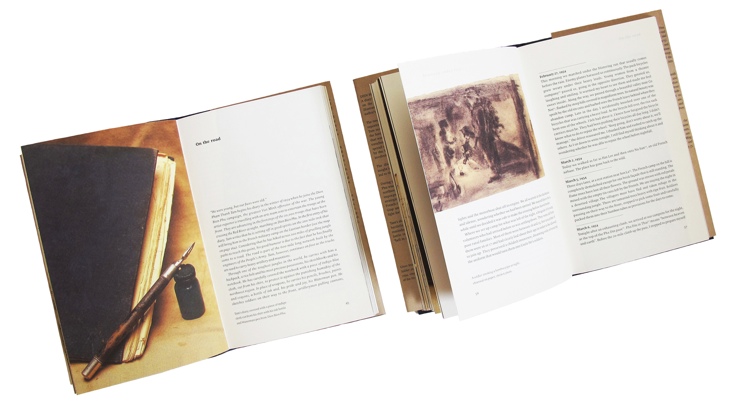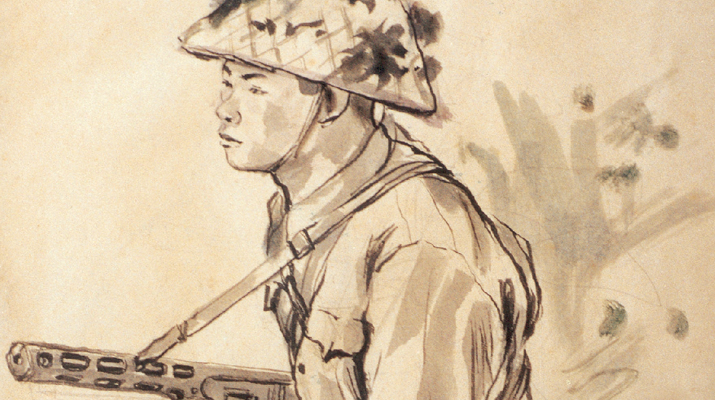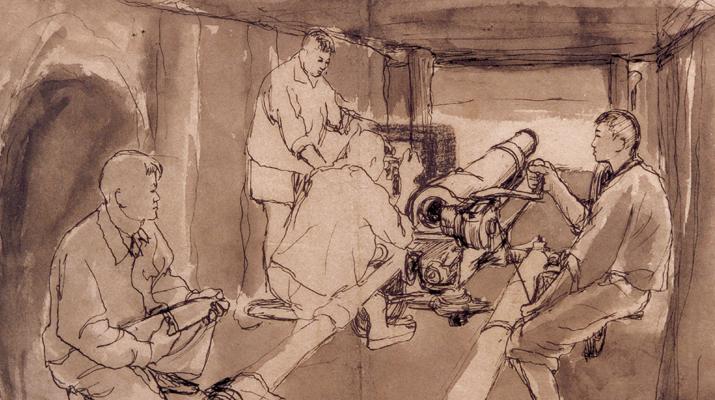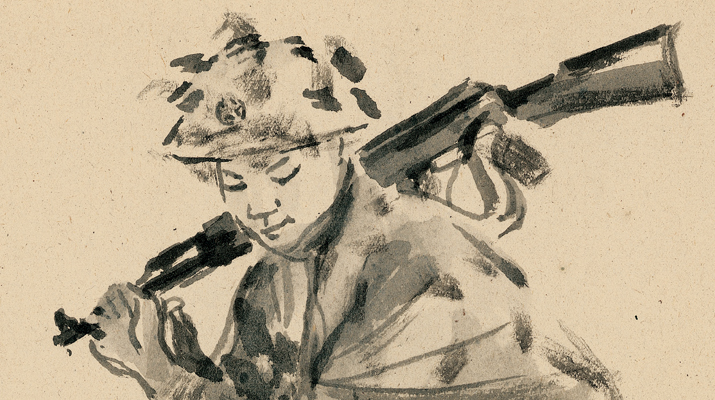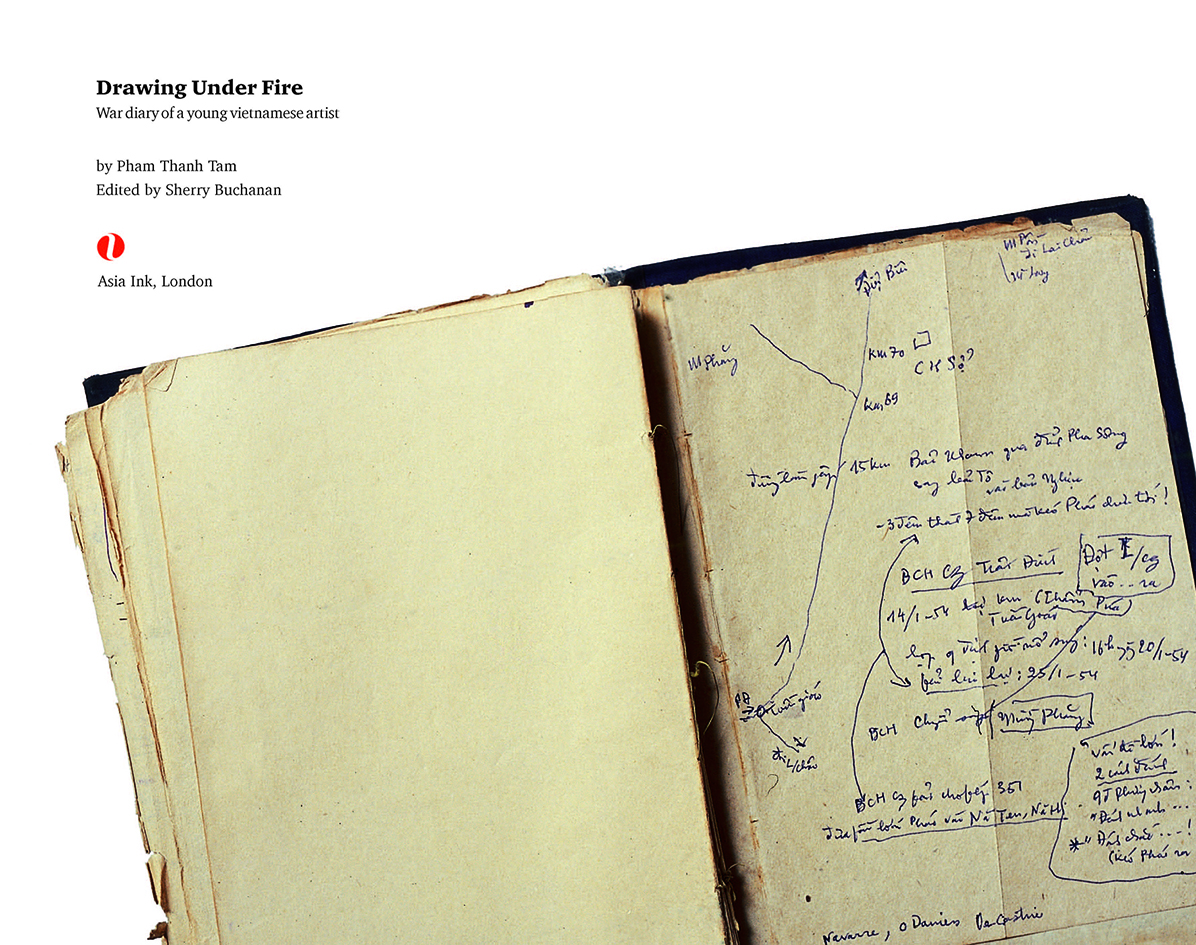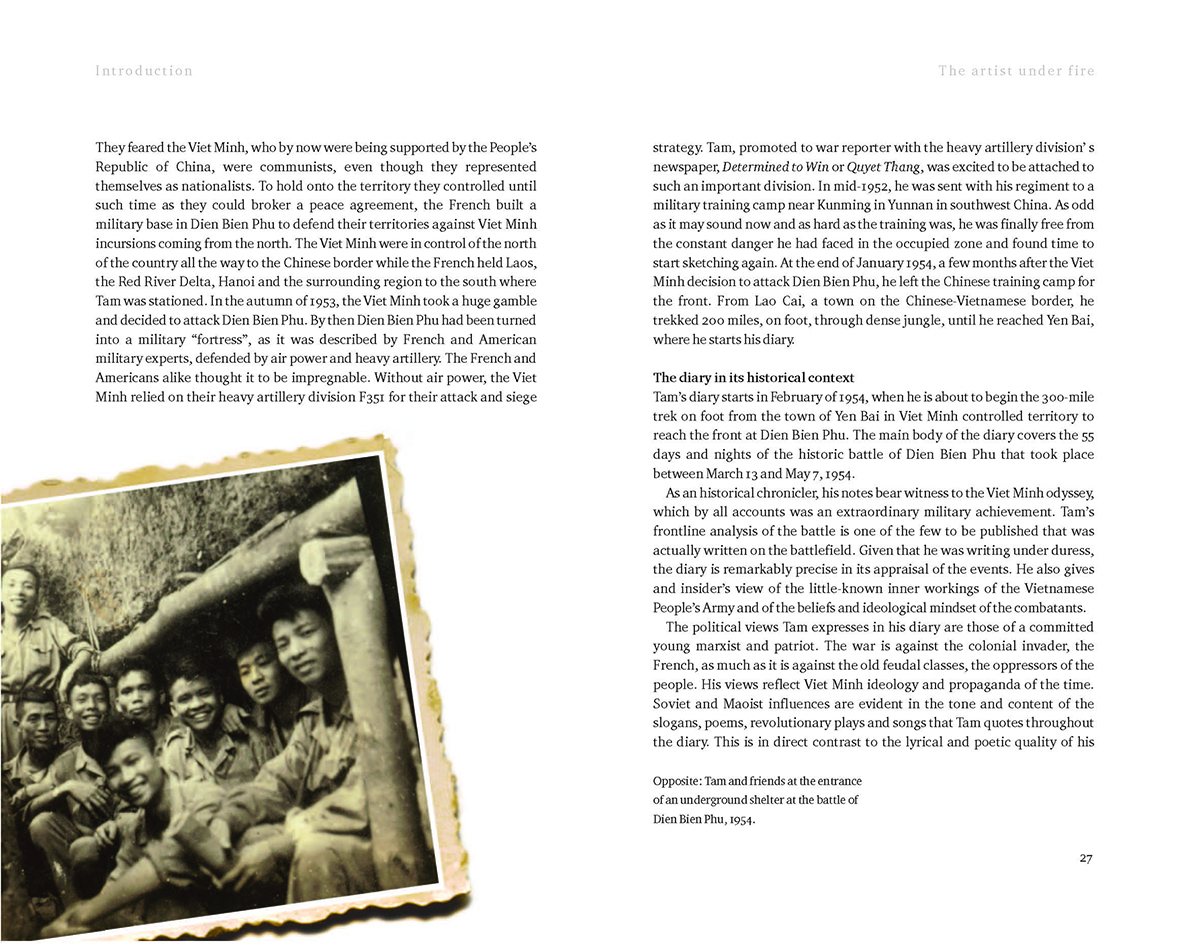Drawing Under Fire

Drawing Under Fire
War Diary of a young Vietnamese Artist
Phan Thanh Tam
Author
Phan Thanh Tam is a war artist and journalist and retired colonel of the People’s Liberation Army.
Editor
Sherry Buchanan
Specification
Published by
Asia Ink 2005
ISBN 978–0953783939
Hardback with jacket
22.4 x 14.8 cm
192 pp
Illustrated in colour throughout
Printed in Italy on GardaMatt Art watercolour paper
Additional Information
Drawing Under Fire was translated into French by Sherry Buchanan and published by Armand Colin in 2011 under the title:
Carnet de guerre d’un jeune Viêt-Minh à Diên Biên Phu
French Kindle Edition now available
Artist and military reporter, Pham Thanh Tam was 22 years old when he wrote his diaries and created his sketches at the battle of Dien Bien Phu during the Franco-Vietnam War (1946-1954). Unarmed, carrying his paint brushes, Chinese ink, chalk, and pencils, Tam trusted his companions with his life and drew sketches of his comrades in arm. Under fire, he marched through the punishing Tonkin jungle to the remote valley of Dien Bien Phu, moved around the battlefield, through the muddy, bloodied trenches, joined in digging teams and slept 20 feet underground next to the camouflaged cannons. Tam’s account benefits from his unique position as an Army reporter attached to the heavy artillery division, the division that was decisive to the Vietminh offensive s against the French. He had access to key information sources, from his frontline perspective, and from his vivid reporting and incisive analysis. As a personal tale, these images express a young man’s coming of age during times of war, and underscore his sense of humour and compassion under fire. Tam’s pensive, tender, and lyrical sketches are rare documents that have survived the battlefield–fragile images on notepaper that show one artist’s ability to sketch beauty in the midst of the terrible battle journalist Bernard B. Fall baptised “hell in a very small place.”
‘Pham Thanh Tam’s Drawing Under Fire is an amazing book…His is an incredible story; his illustrations and reportage are equally memorable.’
The Times
‘This is an extraordinary secret history by Vietnam’s lost war artist.’
The Independent
‘[A] poignant and elegant book…The diary is illustrated with beautiful and elegant sketches and watercolours. This is a must read, for the strength of the account told without hatred.’
Lepoint.fr
‘One of the rare, perhaps the only Vietminh diary of this battle. All the more credit to the American journalist Sherry Buchanan for having found and meticulously edited this account.’
L’Express
‘This exceptional diary offers a new perspective on the French Indochina War.’
Le Club Histoire
Reviews
In the British Media
BBC Radio
‘Drawing Under Fire is the Vietnamese equivalent of Graham Greene’s The Quiet American. A unique wartime diary, more exciting than fiction with extraordinary drawings and sketches done during the battle of Dien Bien Phu.’
Philip Dodd, Night Waves, BBC Radio 3, 11 May 2005
Drawing Under Fire is a poignant and timely insight into the North Vietnamese side of the conflict.’
BBC Radio Humberside, 02 June 2005
‘Drawing Under Fire is a unique and thoroughly fascinating diary of words, drawings and painting.’
BBC Radio Jersey, 07 June 2005
‘Drawing Under Fire is an innovative and beautifully presented book.’
BBC Radio Wiltshire, 13 June 2005
The Guardian
‘Pham Thanh Tam holds up his old army helmet, a testimony to his war years. It is rusty and riddled with holes. “I know you think these are bullet holes,” he says. “If they were bullet holes I would be dead. I made these holes after the war. I used the helmet as a watering can for the garden.” This 67-year-old war artist and colonel in
the North Vietnamese army is a veteran of the Indochina (1946-54) and Vietnam (1965-75) wars. His energy and zest for life got him through 30 years at the front and some of the deadliest battles of both wars. Today his special brew of fermented banana juice gives him a little extra boost.
“These legs have hiked thousands of miles up and down the Ho Chi Minh Trail, all the way to Halong Bay, and down to the south during the Tet offensive. I travelled everywhere to sketch the war,” he says.
His first sketches were of the battle of Dien Bien Phu (1954), where he fought against the French in the trenches for 55 days and nights. Under fire, he developed a talent for telling a story with a few brushstrokes in a matter of seconds: a picture of a medic looking after a wounded soldier communicates compassion and humanity in war. He learned the croquis rapide (quick sketching technique) in the Viet Bac, Ho Chi Minh’s remote jungle headquarters during the Indochina war. His teachers were some of the most talented artists of their generation. Inheritors of the French neo-classical style introduced to Vietnam in 1925, they followed Ho Chi Minh into the jungle and set up an art school there to teach “art for the people”, a mix of the French style and Soviet-inspired socialist realism. Some of the results can be seen in the exhibition Vietnam Behind the Lines, which opens at the British Museum this week.’
Sherry Buchanan, ‘Drawing Fire,’ The Guardian, 10 June 2002
The Independent
This is an extraordinary secret history by Vietnam’s lost war artist. In 1954, Pham Thanh Tam kept a diary of life on the front in the war for independence. It was then hidden away until a chance meeting fifty years later.
Sherry Buchanan, ‘Vietnam’s Lost War Artist,’ The Independent, 25 May 2005
The New York Times
Artists also boosted the morale of combat soldiers…as the artist Pham Thanh Tam told Sherry Buchanan: ‘Soldiers enjoyed it, having me around drawing. They thought it was relaxing. To have someone remembering you by drawing you — it was like telling a beautiful girl she was beautiful’.
Alan Riding, ‘The Vietnam War as Seen in Art From the Other Side,’ The New York Times, 22 November 2002
Publishing News
‘Drawing Under Fire [is] a beautifully produced edition of a war diary by a young artist, Pham Thanh Tam, written and sketched during the epic battle of Dien Bien Phu (1954). In this poetic document, discovered by Asia Ink’s founder and publisher Sherry Buchanan, a young man seeks to share his dreams of beauty and love with his fellow-soldiers.’
Vivienne Menkes, Publishing News, 19 November 2005
The Times
‘Pham Thanh Tam’s Drawing Under Fire is an amazing book. Tam was 15 when he joined the resistance against the French after his home was destroyed in the 1946 French bombing of the city. Living under cover, he sketched and reported what he saw. In 1954 he covered the historic battle of Dien Bien Phu. Later, during the Vietnam War, he was an official artist throughout the Tet offensive. His is an incredible story; his illustrations and reportage are equally memorable.’
Tim Teeman, INTERALIA Book Review, The Times, 11 June 2005
In the French Press
L’Express
‘ “We were young but our faces were old.” In February 1954, the twenty-two year-old Pham Thanh Tam, painfully thin after seven years of conflict but still full of enthusiasm, leaves for Dien Bien Phu, wearing his sandals and rice belt. Armed only with pencils and brushes, the student of the Hanoi Fine Arts Institute, trained in French classical drawing, is attached to the Vietminh artillery division. He keeps a diary and draws in pencil, ink and watercolour what he sees during and after the battles: landscapes burnt by napalm and aerial bombings, comrades in arms, wounded and frightened or buoyed by the sayings of Uncle Ho, fire and death. If this illustrated diary is not without its ideological clarion calls, it is one of the rare, perhaps the only Vietminh diary of this battle. All the more credit to the American journalist Sherry Buchanan for having found and meticulously edited this account that ends in August 1954, when Tam returns to Hanoi. “Every fall I have the feeling that we will go to war,” he writes. Ten years later, he is called upon to draw the first American plane shot down over North Vietnam. Today, Pham Thanh Tam is a retired colonel of the People’s Army who lives and paints in Ho Chi Minh City.’
Emmanuel Hecht, ‘The last French battle seen from the Viet-minh side: An extraordinary testimony,’ L’Express, 14 March 2011
READ MORE
Le Figaro
‘There is an extensive bibliography of the battle of Dien Bien Phu, the epic event that in May 1954 signaled the death knell of French Indochina. However the rarity of Vietminh contemporaneous accounts of this momentous battle makes this recently discovered diary of a twenty-two year-old soldier all the more precious. Pham Thanh Tam was a student at the Hanoi Fine Arts institute when he enlisted with the artillery division as a war reporter. With his maquisards comrades, he sets off on a five hundred-kilometer trek through the punishing Tonkin jungle to Dien Bien Phu where General Navarre, commander of the French Far East Expeditionary Corps, had built a French military base deemed to be impregnable. To secure the base, the ‘red ants’ of the Vietnam People’s Army pulled their two-ton canons on marches that lasted up to twenty-hours a day, dug trenches and built underground casemates. The battle raged for fifty-five days until the surrender of the French commander General de Castries on the 7th of May.
The revolutionary scribe writes, “Going up in the flames and black dense smoke of the fire were bits of parachutes and steel and wood fragments from the forts”. Tam’s precious diary is crammed with detail. As a revolutionary scribe, above all he records the courage of his comrades. Yet going beyond military censorship, he also expresses their sadness and suffering. The artist is ever present, showcasing his text with drawings and watercolours. Portraits of soldiers, artillerymen in action and dark landscapes of war are contrasted with bucolic scenes that he sketches elegantly between steel deluges of airpower.’
‘Diaries from Indochina,’ Le Figaro, 12 May 2011
READ MORE
Le Nouvel Observateur
‘May 7, 1954, in the valley of Dien Bien Phu, was a traumatic event for the French Army. In the ranks of the Vietminh, Pham Thanh Tam, a twenty-two year-old war reporter, kept a diary of the battle. In this extremely rare diary, the propaganda does not alter the underlying emotions.’
Le Nouvel Observateur, March 2011
Le point.fr
In this poignant and elegant book, Pham Thanh Tam records the events of the battle of Dien Bien Phu from the Vietminh soldier’s perspective. Hundreds if not thousands of books have been written on the Indochina War, the first great conflict of French de-colonisation, that lasted from 1946 to 27 July 1954. The French defeat at Dien Bien Phu on 7 May 1954 remains one of the most traumatic events in French military history. The majority of the accounts of the battle are by French veterans shocked at their defeat against a Vietminh adversary who fought for their homeland under the communist banner. Only a few rare accounts by the victorious enemy exist. This is why Pham Thanh Tâm’s diary is of such significance. When Pham Thanh Tâm begins his diary, although only twenty-two, he has already spent seven years at war. A former student of the Viet Bac Fine Arts College, he is named war correspondent for the artillery division (F351) of the Vietnam People’s Army. He leaves for the front with some blank notebooks, a pen and a Waterman inkbottle as his weapons. The French forces believed the military base at Dien Bien Phu to be impregnable being too difficult for the Vietminh heavy artillery to reach. As the American journalist Sherry Buchanan points out in her introduction: “In order to make their way to Dien Bien Phu, the People’s Army’s engineers would have to purpose-build hundreds of kilometres of roads to make way for their heavy artillery. A feat believed to be impossible by the American advisors and the French generals. Yet, against all expectations, the Vietminh built the roads.” Pham Thanh Tâm chronicles the historic march towards Dien Bien Phu. The two-ton 105mm canons that would smash the French garrison were pulled and hoisted up vertiginous hills, inch by inch, amidst a thousand perils. As for the dismountable canon parts, the soldiers carried them through the steep jungle terrain on their backs. The diary is illustrated with beautiful and elegant sketches and watercolours. This is a must read, for the strength of the account told without hatred.’ Jean Guisnel, ‘The French Defeat at Dien Bien Phu seen from the Viet-minh side,’
Le Point.fr
Le Club Histoire
‘On May 7, 1954, after a siege of several months, the French forces at Dien Bien Phu surrendered to the Vietnam People’s Army. Much has been written on this subject, yet the Vietminh accounts of the battle are extremely rare and we know little of how the conflict was viewed from the perspective of the soldiers fighting on the Vietnamese communist side. This diary, discovered by the American journalist Sherry Buchanan, is an instructive response. The author, a twenty-two year old student of the Hanoi Fine Arts Institute, was a war reporter with the Vietnam People’s Army. In his diary, he records the battle and the thoughts of his fellow soldiers. Although written in the propaganda style of the day, the underlying emotions reveal the universality of suffering in war. Along with an introduction by Sherry Buchanan, this exceptional diary offers a new perspective on the French Indochina War.’
Readers’ Comments
‘A remarkable book,’ Pierre d’Anchalt, Dien Bien Phu veteran, Apt, France
‘I loved Pham Thanh Tam’s diary. Boy, why didn’t we read this before going into Vietnam?’ Douglas Young, American Veteran of the Korean War, Sarasota, USA
‘Great book and a good read,’ Mark Weston, London
‘This diary is wonderful. The author should be elected living treasure for humanity. It’s a great read, and very poignant at times. I understand why they ‘won’ every time, and would win again if it happened again. What an extraordinary young man the author was!’ Marie-Caroline van Herpen, Paris
‘Ton livre que j’ai commencé est passionnant, ce qui est fantastique c’est que dans toute cette horreur il se dégage de ces dessins une espèce de sérénité, due sans doute à la fatalité qu’il faut accepter, quel calme dans cette tempête!’ Reynier Pozzo di Borgo, Paris



